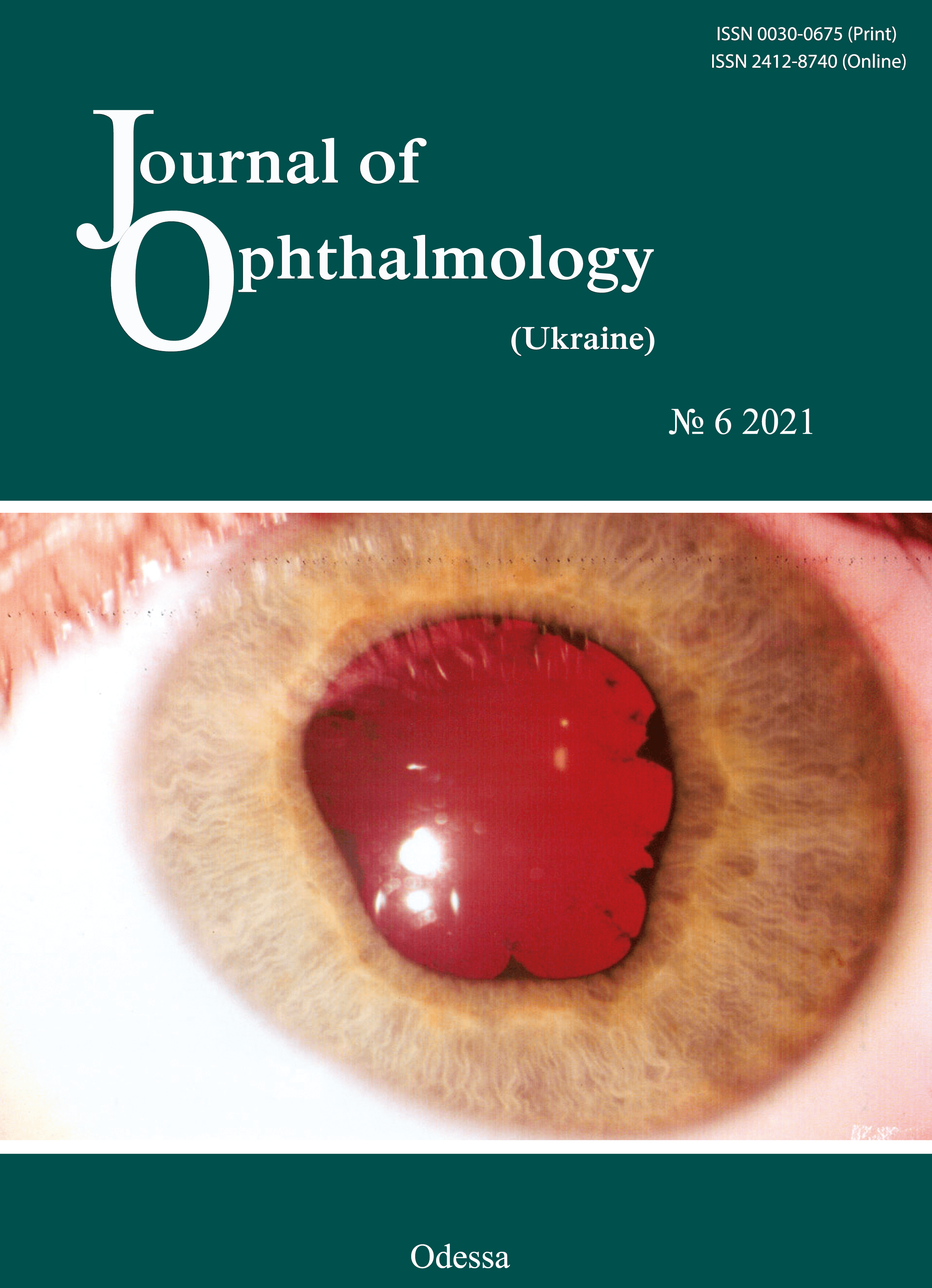Development of new methods of selection of multifocal intraocular correction in cataract surgery
DOI:
https://doi.org/10.31288/oftalmolzh202162124Keywords:
multifocal, intraocular, contact lenses, questionnaireAbstract
Рurpose. Upon obtained information from a questionnaire and trial multifocal contact lenses prior operation, our goal is to present a new methodology to select patients for multifocal intraocular correction with an individual definition of the IOL type.
Patients and methods. An analysis of 1000 medical case reports (540 hyperopia, 460 myopia) and questionnaire of patients who have undergone operation because of cataract and refractive anomalies in the section of lens surgery and intraocular correction, department of eye diseases in Samara regional clinical hospital named after V. D. Seredavin. Patients are offered monofocal IOLs from leading global manufacturers, such as Rayner, H.Optics and Alcon, bifocal IOLs such as M-plus, Comfort (Oculentis), Restor (Alcon) and the trifocal IOL PanOptix (Alcon) for implantation. To get our goal, questionnaires were developed with questions allowing to determine the psychological type of the patient before the surgery, the nature of his/her visual stress besides requirements and expectations after surgery. Multifocal contact lenses Acuvue Moist with varying ADD power are selected to patients before operation to create similar conditions of multifocal intraocular correction. Visual acuity, contrast sensitivity are evaluated 2 weeks and 2 months postoperatively. At the same time, another survey is conducted to evaluate their satisfaction of visual outcomes.
Results. According to analysis, the percentage of implantations of monofocal IOLs was (450 patients) 45%, while percentage of multifocal IOLs was (550 patients ) 55 % among all ultrasound phacoemulsification surgeries. Of these, in (330) 60 % of cases patients have chosen IOLs with a low degree of ADD power (Lentis Comfort), in (165 patients) 30 % — PanOptix and in (55 patients) 10 % — Lentis M-plus or Restor. Degree of satisfaction and visual results in 2 weeks and 2 months was recorded from (5 points) and obtained (506 patients) 92 % and (528 patients) 96 % respectively. Cases with incomplete patient dissatisfaction don’t exceed (18 patients) 3.2 % and is reported mainly in the group with the implantation of bifocal IOLs and are related with typical complaints of light phenomena, mostly at night.
References
1.Pepose JS. Maximizing satisfaction with presbyopia correcting intraocular lenses: The missing links. Am J Ophthalmol 2008;146:641 8. https://doi.org/10.1016/j.ajo.2008.07.033
2.Gibbons A., Ali T.K., Waren D.P., Donaldson K.E. Causes and correction of dissatisfaction a implantation of presbyopia-correcting intraocular lenses. Clin Oph- thalmol. 2016 Oct 11;10:1965-1970. eCollection 2016.https://doi.org/10.2147/OPTH.S114890
3.Peng C, Zhao J, Ma L, Qu B, Sun Q, Zhang J. Optical performance after bilateral implantation of apodized aspheric diffractive multifocal intraocular lenses with +3.00-D addition power. Acta Ophthalmol. 2012;90(8):e586-93.https://doi.org/10.1111/j.1755-3768.2012.02497.x
4.Pearce JL. Multifocal intraocular lenses. Curr Opin Ophthalmol 1996;7:2 10.https://doi.org/10.1097/00055735-199602000-00002
5.Stebnev V.S., Stebnev S.D., Malov I.V., Skladchikova N.I. Our rst experience implantation of trifocal intraocular lenses Acrysof IQ PanOptix. Modern technologies in ophthalmology 2017:6:106-107 (In Russ). https://doi.org/10.25276/2686-6986-2018-1-181-183
6.Breyer D.R.H., Kaymak H., Ax T., Kretz F.T.A., Au arth G.U., Hagen P.R. Multifocal Intraocular Lenses and Extended Depth of Focus Intraocular Lenses. Asia Pac J Ophthalmol (Phila).2017 Jul-Aug;6(4):339-349. https://doi.org/10.22608/APO.2017186
7.Kohnen T, Titke C, Böhm M. Trifocal Intraocular Lens Implantation to Treat Visual Demands in Various Distances Following Lens Removal. Am J Ophthalmol. 2016 Jan;161:71-77.e1.https://doi.org/10.1016/j.ajo.2015.09.030
8.Alio J.L., Pikkel J. Multifocal Intraocular Lenses: Neuroadaptation. Multifocal Intraocular Lenses. Springer International Publishing, 2014. P. 47-52.https://doi.org/10.1007/978-3-319-09219-5_5
9.Davis R.A. Fitting Tips for Presbyopic Success. Review of Cornea and Contact Lens. 19. 2010. Oct.
10.Hudson C. How to succeed with multifocal contact lenses. Optometry Today. 2011;51(11):3.
Downloads
Published
How to Cite
Issue
Section
License
Copyright (c) 2025 M. A. Alnoelaty ALmasri, V. C. Stebnev

This work is licensed under a Creative Commons Attribution 4.0 International License.
This work is licensed under a Creative Commons Attribution 4.0 International (CC BY 4.0) that allows users to read, download, copy, distribute, print, search, or link to the full texts of the articles, or use them for any other lawful purpose, without asking prior permission from the publisher or the author as long as they cite the source.
COPYRIGHT NOTICE
Authors who publish in this journal agree to the following terms:
- Authors hold copyright immediately after publication of their works and retain publishing rights without any restrictions.
- The copyright commencement date complies the publication date of the issue, where the article is included in.
DEPOSIT POLICY
- Authors are permitted and encouraged to post their work online (e.g., in institutional repositories or on their website) during the editorial process, as it can lead to productive exchanges, as well as earlier and greater citation of published work.
- Authors are able to enter into separate, additional contractual arrangements for the non-exclusive distribution of the journal's published version of the work with an acknowledgement of its initial publication in this journal.
- Post-print (post-refereeing manuscript version) and publisher's PDF-version self-archiving is allowed.
- Archiving the pre-print (pre-refereeing manuscript version) not allowed.












